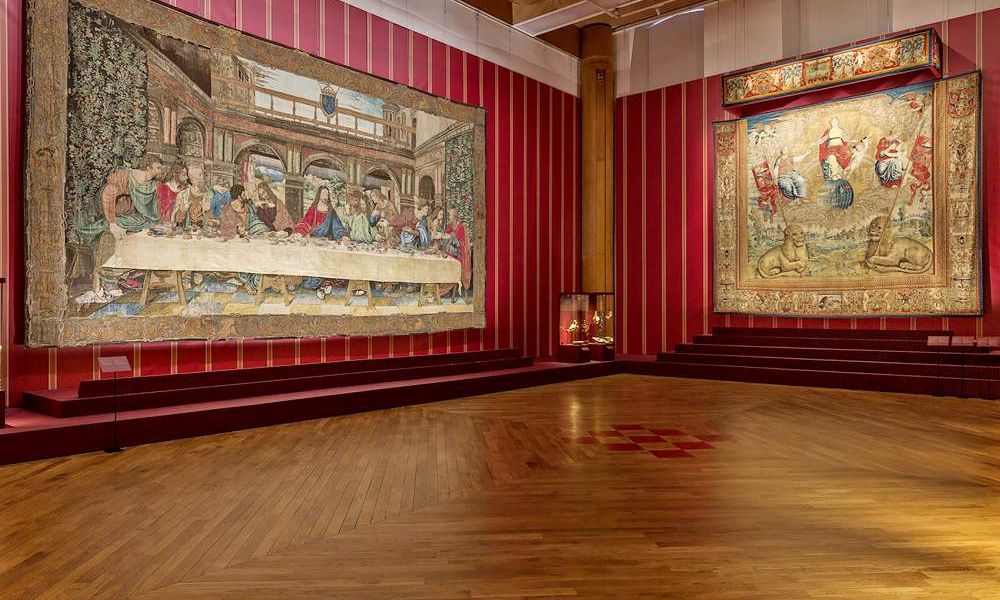In Leonardo's Shadow: Tapestries and Ceremonies at the Papal Court is at the Venaria Reale palace outside Turin Photo: Beppe Giardino
A new exhibition at the Reggia di Venaria, curated by Andrea Merlotti and me, brings two extraordinary works in exceptional condition from the Vatican collections to the Baroque palace northwest of Turin. In Leonardo’s Shadow: Tapestries and Ceremonies at the Papal Court (until 18 June) reveals the 16th-century tapestry of Leonardo’s Last Supper and the papal throne canopy of Clement VII.
A copy of Leonardo’s 1494-98 mural painting in the refectory of Santa Maria delle Grazie in Milan, the tapestry is woven entirely from gold- and silver-covered silk. It arrived in Rome in 1533 as a gift from King Francis I of France to Pope Clement VII on the occasion of the wedding between the pontiff's niece, Caterina de’ Medici, and Henry of Valois, the second son of the king. Their union sealed the strategic alliance between the papacy and the “most Christian king” of the French against the Holy Roman Emperor and king of Spain, Charles V, whose mutinous troops had sacked Rome only a few years earlier.
Around the same time, the canopy was woven on commission from Clement VII (or perhaps already from Leo X) by the renowned Brussels tapestry-maker Pieter Van Aelst, whose workshop had already delivered the famous Raphael tapestries for the Sistine Chapel, based on cartoons by the talented students of Raphael, Perino del Vaga and Giovanni da Udine.
The two tapestries came to be associated with one of the most important ceremonies of Holy Week, the washing of feet. The exhibition recreates the traditional setting of the Holy Thursday ritual in the majestic Ducal Room of the Vatican Apostolic Palace and later at St Peter’s, where the ceremony was relocated in the 19th century to accommodate the increasingly large crowds. In imitation of Christ washing the disciples’ feet before his crucifixion, the pope washed the feet of 13 priests beneath the shadow of the tapestry of the Last Supper, an important Eucharistic symbol, which was mounted on the wall together with the canopy of Clement VII.
The ceremony’s called for special robes in fine white woollen cloth for the priests, symbolically known as “apostles”, whose feet were washed and who received small bunches of fresh flowers and two medals, one in gold and the other in silver.
Venaria Reale is showing four rare 18th-century paintings of this solemn rite on loan from the Museo di Roma and the Villa Lagarina Diocesan Museum, together with two previously unexhibited drawings from the Vatican Museums and a selection of 19th-century lithographs. The ceremony was followed by a banquet—represented in the exhibition by paintings and woodcuts—that was served by the pope himself and decorated with sugar sculptures.
The washing of feet attracted a large audience, which also included princes and rulers. Cardinals, sovereigns and nobles imitated the pope’s gesture in the hospice of the Santissima Trinità dei Pellegrini church in Rome. This spirit of emulation quickly spread to the most important European courts where, as some of the works in the exhibition demonstrate, Catholic sovereigns repeated the ceremony in the presence of tapestries or paintings depicting the Last Supper.
Charles Felix, duke of Savoy, wanted to install a copy of Leonardo’s Last Supper in the Royal Palace of Turin to get as close as possible to the papal ceremony he had witnessed in Rome and the original biblical episode—recalled in the show by a beautiful Gobelins tapestry from the Palazzo del Quirinale, as well as jugs and basins from the Turin palace and the Vatican’s Office of Liturgical Celebrations.
The exhibition tells the story of this important moment in the New Testament and its visible expression in a ritual ceremony that was forged over the centuries.
• Alessandra Rodolfo is an art historian and curator in charge of the department of 17th- and 18th-century art and of the department of tapestries and textiles at the Vatican Museums
• In Leonardo’s Shadow: Tapestries and Ceremonies at the Papal Court, Reggia di Venaria Reale, near Turin, until 18 June

